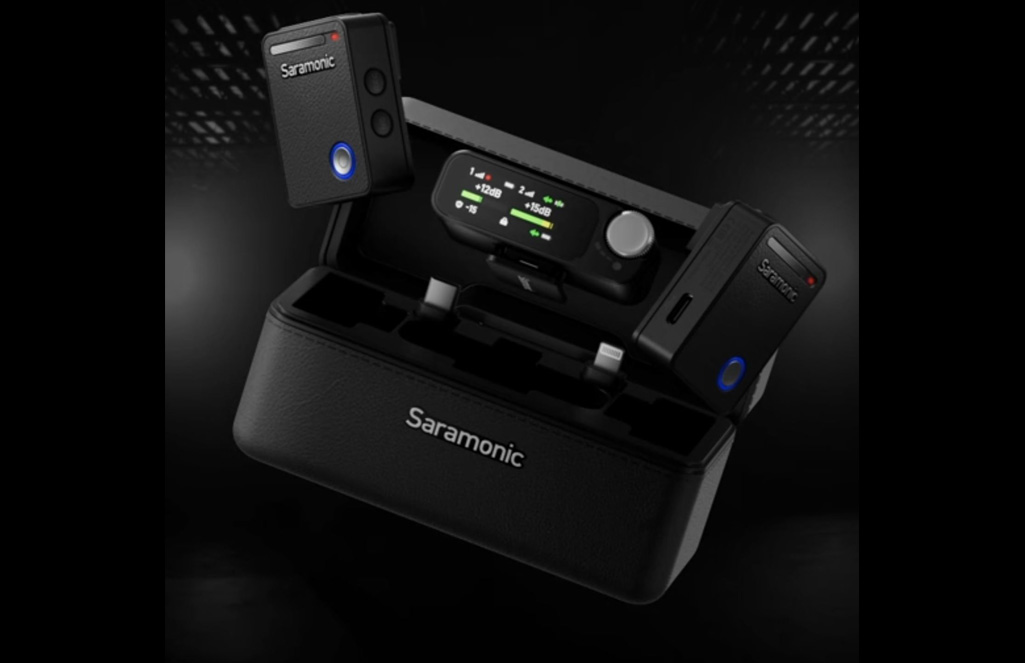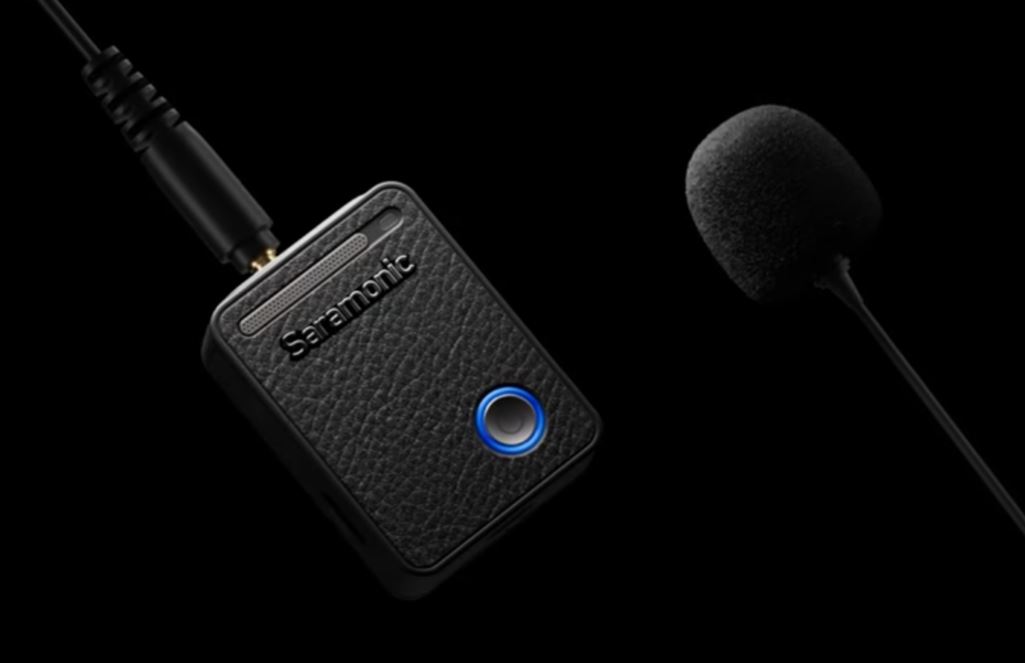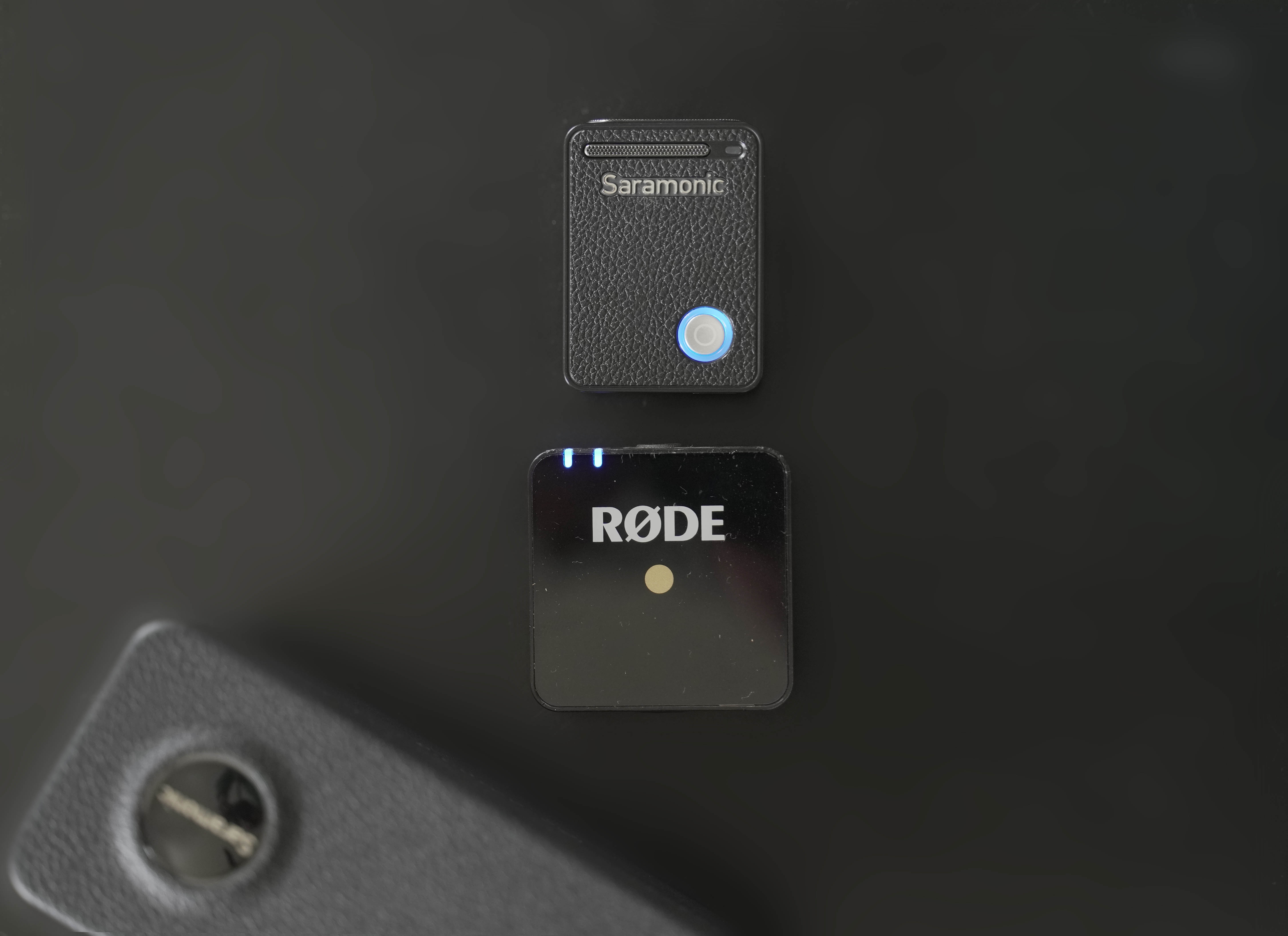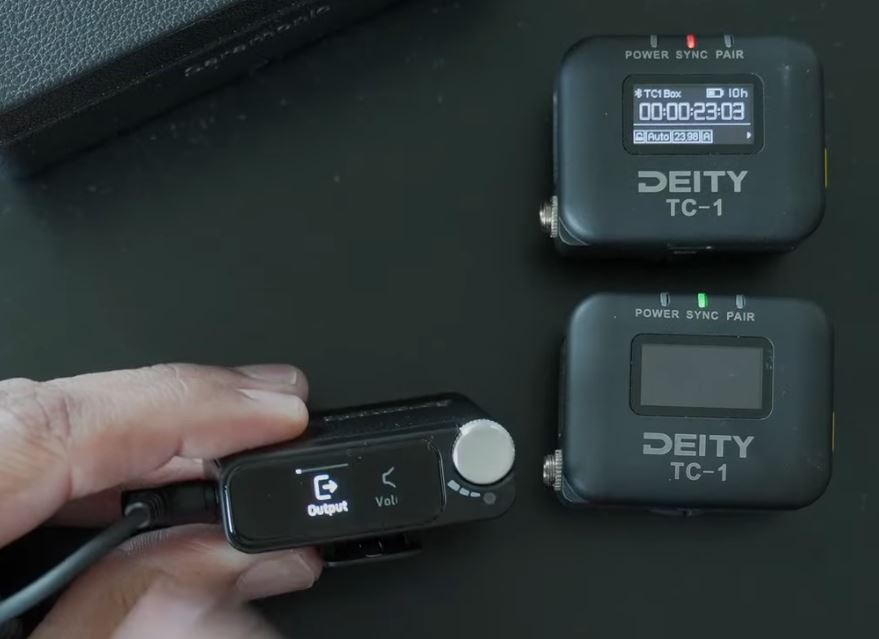The Saramonic Ultra – Mega Review
31 Jan 2025, Posted by in Art, Design, Reviews, Uncategorized
In the last two years “consumer” (or perhaps, prosumer) wireless systems have overtaken professional wireless mic systems, offering better features, and audio quality that is essentially indistinguishable from the pro models. Which is a long way of saying that you no longer need an $800 wireless lav system: Rode, DJI, and now Saramonic effortlessly fill those needs for less than half the price. There are a couple of “pro” features that are missing from this trio (which I’ll talk about later), but they compensate with other abilities with even greater functionality and ease. This is the Saramonic Ultra review, and it’s arguably the best out there right now. It has a few tricks up its sleeve, and I’ve solved the mystery of syncing the Ultra with other timecode devices like the Deity TC-1, which I’ll share here.

The Saramonic Ultra offers all of the big name features: 32 bit float internal recording, internal timecode, and a 300 meter range. Two of these features you won’t find in the industry standard Sennheiser G3/G4 series—internal recording and timecode. It also offers pretty much every feature you’ll find in the wireless universe: magnetic clips, safety tracks, noise cancelation, 3.5mm lav input, USB-C and Lightening connectivity, and a touch screen. More importantly, it has top tier audio quality (more on that later, too). And it offers a couple of features rarely seen anywhere in the wireless lav multiverse: IPX5 water resistance rating for the transmitters (not the receiver), a detachable antennae to strengthen the signal, and a “vocal boost” setting that essentially spikes the upper frequencies for a sharper, brighter voice. If this sounds like everything and the kitchen sink… well, it is. The only “missing” feature is Bluetooth; if you want to connect to the Saramonic app you have to do it physically. This might seem like an inconvenience, but almost all the features are accessible on the unit itself. Really, all of the best features you’ve ever seen in a wireless system have been packed into the Ultra. The question is whether they perform at all the best levels?
To reach full IPX5 water resistance
you need to use the windscreen
to plug the 3.5mm jack... so don't
run it under the faucet like I've seen
some YouTubers do.
Here I should stop and say that one of the remarkable things about the Ultra is that it’s less expensive than the DJI and Rode versions that it competes against. Why? Well, because Saramonic is not as well known as those brands. Saramonic has been around for quite some time, however. I’ve always been a bit of a “look outside the trend” kind of buyer. My first wireless system, nine years ago, was a Saramonic uwmmic9. For several years Saramonic nibbled around the edges of the budget wireless marketplace, offering products like the Blink series. With the Ultra, they’ve gone all out.
The $299 Saramonic Ultra has impressive build quality. The transmitters are smaller than the Rode Wireless Pro and DJI 2, but they have some heft. The front side of the transmitter is far less distracting than the DJI, and much more functional than Rode with clear indicators for connection, noise reduction, and recording. The matte body makes scratches less… well, important somehow. It comes with two lav mics and all the usual accessories. The box is a charging case and nicely compact; it, too, is smaller than other charging cases I’ve had. I’ve owned wireless systems from Sennheiser, Rode, Hollyland, Godox, Synco, and Neewer… in other words, an absurd number that I can use for comparison.

If you’re looking at wireless systems like the Rode Wireless Pro and the DJI Mic 2, the big question you probably have about the Saramonic is sound quality. This isn’t their first wireless rodeo, and it shows. The audio quality is every bit as good as the Rode and I find it slightly clearer and better balanced (I don’t own the DJI). Every mic system has a signature sound characteristic—most Rode mics, for example, tend to have boosted warm bass tones. The Saramonic keeps some of that lower resonance in a less warm, more neutral tone, and avoids the mid-range boxiness of cheaper systems. What’s more, Saramonic has the greatest SPL (Sound Pressure Level, or maximum volume level) at an impressive 130 SPL… at least on paper. It’s difficult to find a lav mic with a higher SPL regardless of price. And it has the best signal to noise ratio of any compact wireless system at 90dB. The Rode Wireless Pro, in comparison is 123 SPL and 72dB; the DJI Mic 2 has a SPL of 120, and a non-comparative SNR rating. The $400 Rode has internal timecode; the $350 DJI does not (and it’s missing lav mics). So the Saramonic costs less and has better features than its competition… but I digress.
I tested the audio quality of Saramonic against my Sennheiser G3 and my first generation Rode Wireless Go. There are signature characteristics to both these systems: The Rode I described before; its warm, enhanced bass and slight high frequency boost make it very pleasant in raw form, but less malleable in post. It will add tonality to whatever lav mic you’re using, which can help with less expensive mics and hinder high quality versions. The Sennheiser is well balanced but slightly thin. It doesn’t add much “color” or tonality to whatever lav mic its connected to, which is generally a good thing. It’s not exceptionally pleasant sounding raw but you’ll have plenty to work with in post. The sound characteristics of the Saramonic fits between these two. There is a boost in the low frequencies and edge in the highs; it’s less “sexy” than the Rode but more malleable in post, especially when working with the 32-bit files.
Speaking of the lavs… how do they perform? These are mid-grade mics. As such they’re better than what I expected for an included accessory. I prefer the sound of mics on the transmitters themselves (they’re brighter with a smoother, less boxy, upper mid), but given the nature of my work it’s unlikely I’ll use them without a lav of some sort. The included mics don’t have the clarity and neutrality of the Sanken Cos 11D ($350) of course, which frankly sound darn great when paired with the Saramonic Ultra. If you already own a great lav, you’ll be a happy camper. If you don’t, the included lavs are quite usable for professional sound, even if they’re not top quality. Given one of the major limits of all lav mics (which I’ll touch on in a bit), the Saramic lavs are a nice addition for audio. By themselves, I would have priced these around $50 each, which is remarkable given the $299 price tag for the complete system.
There are tons of YouTube reviews that test the long-distance capabilities of the system. They all seem to agree that within the line of sight, facing the receiver, you can achieve the acclaimed 300 meter distance. From a cinematographer’s standpoint, I think it’s absurd to film someone at that distance and expect to hear them talking; just ADR it in post. An exception might be for certain sports or activities. You might want this range if you film a rock climber talking about what they’re doing, but that’s a fairly niche application. Personally, I’m more interested in how it performs at shorter distances with obstacles to the line of sight… something you might experience when filming a lecturer who paces the hall. So I attached the included antennae, chose a distance of 50 feet, and started experimenting. The Saramonic stayed connected both when my back was turned and when I crossed behind a structure. Of course, in every situation you have the ability to capture the audio on the transmitter itself, ensuring that you’ve always got a pristine copy. I uploaded a test video to YouTube.
And thus far, the internal copy have been pristine. I’ve had no difficulties with glitches or poor audio using the internal recorders. However, I did find a quirk when transferring files. For some reason, the transmitter didn’t like my desktop system. It would either have problems indexing the folder on the transmitter or show the files but not transfer them. On my laptop, however, the transfer worked quickly and smoothly. I’m still trying to understand the error and have reached out to Saramonic for advice.
At 8GB, the equivalent of 10-ish hours, you’ll need to back-up your recorder daily. When you reach the limit, it will start recording over the files. The clips are divided into 30 minutes clips, so you lose 30 minutes at a time.
THOSE LITTLE IMPORTANT SPECS
With all manufacturers we rely on their rigorous and honest testing by the manufacturer… this is a given. And I’m not suggesting that Saramonic or anyone else is fudging the numbers. But let’s keep the phrase “on paper” since we can’t test everything for ourselves. If you compare the Saramonic Ultra to an industry standard like the newest Sennheiser G4, the G4 transmitter has a greater SPL at 140 (but are then limited by the lav’s SPL), and an identical Signal to Noise at 90dB. Its operating range is one-third the distance (100 meters). The Sennheiser audio quality is first rate, but when you connect a high quality external lav mic to both units, it’s impossible to discern the difference. The Saramonic offers internal recording and timecode, is smaller, and more flexible. And, of course, the Sennheiser is $850 for a single transmitter/receiver unit… almost triple the cost with no ability to add a second transmitter. The G4 and other strictly “pro” wireless systems do have three features that aren’t part of the Saramonic, Rode, or DJI offerings, however. The first is replaceable batteries. This extends the life of the units years beyond that of the Saramonic/Rode/DJI units. I have a 9 year-old G3 that works flawlessly. The Sennheisers are also built like tanks, and can take twice the beating of the Sara/Rode/DJIs. The G4 system will also search for a new channel if there is interference. In the past this has been something that professional crews have relied on. With the introduction of internal recording, however, the frequency-jumping feature becomes fairly moot. An internal recording will be more reliable than a frequency switching system, and with timecode it’s easier to sync in post.
Timecode can be an incredibly helpful feature if your audio is being recorded separately from your video or you’re using more than one camera. Most small productions use cameras that don’t accept timecode internally (you can’t jam—or reset—the timecode in the camera itself and then disconnect the timecode device). The big question, then, is can the Saramonic sync with another timecode device, and thus become an additional timecode device for audio-based TC? The answer, thankfully, is yes. I made an instructional video of the process here.
The Saramonic can’t accept timecode from the Deity TC-1, but it can jam the timecode to the Deity easily. First you’ll need to configure your Ultra to be in Timecode Mode 5. Then you’ll need to put your Deity into AUTO JAM mode. Connect the two via 3.5mm cord and the Deity will sync after a few moments. You can then sync all of your Deity devices wirelessly. Simply return your first TC-1 to Master mode; set your other Deity devices to AUTO JAM, and the set the Master to SYNC (under the TC menu). Check out my YouTube tutorial for a step by step guide.

The Ultra can act as a Master for
the Deity TC-1 timecode system
A single Diety TC-1 costs about $150 by itself, so having an “additional” unit with the Saramonic is super useful, to the point of a game-changer in some of my multi-cam work.
You can’t escape reviewing the noise reduction on these units… it’s like those silly effects on LED lights. In one respect, the NR feature does an incredible job of stripping away almost all background noise. But it can only do this by stripping away frequencies that also exist in the voice. Most NR systems will then gate and compress the frequencies of the voice to try and recover the audio, but the result is often boxy and clipped. That’s science, not magic. The Ultra has 3 NR settings, and I’ll say Level 1 does a good job of removing “light” background noise like fridges and ventilation while leaving the voice uncompromised.
A lot of reviewers ask the question: Is the Saramonic Ultra better than the Rode Wireless Pro… or the DJI Mic 2. If you need all three of the major features—internal recording, 32 bit float, and timecode—then the answer in my opinion is a resounding yes. If you need just two of the features, the lower price, excellent build quality, and great flexibility also mean “yes.” But frankly, I think the question you should be asking is, “is the Ultra better than the Sennheiser G4?” Frankly, I think the answer is still yes. It may not be better in every way, but it’s better in most.
You may really want the uncompressed sound quality of the $850 Sennheiser system. When considering a wireless lav system, I keep in mind that none of them are built for premium sound… compressed or not compressed… even when paired with high end lavs like a Sanken. The lav mic size, its placement on the chest, and omni directional pattern aren’t optimal for capturing sound. A thousand dollar lav system will never sound as rich and open as a quality $300 condenser mic. A great lav will only be a good mic, regardless of the system. So before adopting a “best quality at any price” approach, remember that a lav mic is something of an audio engineer’s tool of last resort… when no other mic can be placed in an optimal position. In a big production it’s more likely to be a back-up mic for whatever is boomed from above. In smaller shoots, corporate gigs, and indie films, however, a wireless lav may be your only option for sound. For all of these situations, the Saramonic system works great, and this system is now my go-to lav system (despite still owning a Sennheiser, a Rode, a Godox, a Neewer…).
What I love.
The Saramonic Ultra has everything: the ability to work with phones or camera, timecode, internal 32bit float, first class audio specs. It’s well made and smaller than the DJI and Rode. And it sounds great. This is a one stop kit that will handle every recording situation, from ambient field recordings to SFX, to two person interviews. How long will it last? That’s the $300 question, and there’s no way to know other than through trial.
What’s not to love?
Very, very little.The innovative locking USB-C/Lightening adapter is clever but leaves the impression that it’s a break hazard on phones and action cams. I really wish the 3.5mm cable and antennae fit into the charging case for more portability. That would keep all of the truly necessary bits together. You have to plug it into your phone to use the app, which isn’t optimal, but almost all of the features can be accessed on the receiver. I thought that I wouldn’t like the faux leather texture of the units and case, but it’s so subtle that it just adds a nice touch. Your preference may vary. But all of this is knit-picking, and many of these issues are found in the competition. Honestly, the only real pain point on the Ultra is the lack of replaceable battery. This may doom the unit to 4-5 years of use, which is unfortunate. Rode recently made a statement promising to have replaceable batteries in their future line; I hope Saramonic takes the same step. But from where we stand today, the Ultra’s really are ultra… leading the pack and well worth the money.
Incidently, Saramonic is releasing a digital hotshoe adapter for Sony’s mult-purpose hotshoe. This would be an added bonus for those of us who hate wires—but more importantly I hope it encourages more innovation from Saramonic. The Sony multi-shoe is capable of four audio inputs, and it would be great to utilize this feature in the future. Currently, an audio-out timecode setup uses one channel, which means a two-mic setup will feed both signals into a single channel. With the multi-purpose shoe you can separate your mics and have the TC on the third channel. They could also make a wireless shotgun mic (hint, hint) that could go into that channel as well.
Where to buy? I like B&H Photo: https://www.bhphotovideo.com/c/product/1859578-REG/saramonic_ultra03_ultra_2_person_digital_wireless.html

Sorry, the comment form is closed at this time.